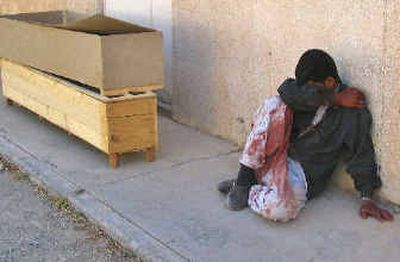Explosions bloody Iraq

BAGHDAD, Iraq – Insurgents unleashed a deadly series of suicide bombings Wednesday, killing at least 69 people in three cities as U.S. Marines pressed their offensive near the Syrian border.
The bombers struck in Baghdad, Tikrit and Hawija, killing shoppers, day laborers and police recruits on the bloodiest day since the formation of the new Iraqi government late last month triggered an unprecedented onslaught of attacks. The worst, a suicide car bombing in Saddam Hussein’s hometown of Tikrit, killed at least 33 people and injured 92, officials said.
The bombings brought to at least 400 the number of people killed in what is turning into a sustained attempt by the Sunni-led insurgency to derail the first Shiite-dominated government to come to power in the Arab world. Insurgents averaged about 70 attacks a day at the start of May, up from 30 to 40 a day in February and March, said Lt. Col. Steven Boylan, a spokesman for U.S. forces in Iraq.
The latest violence came amid a major U.S. Marine operation in northwestern Iraq aimed at hunting down insurgents believed to be responsible for many of the suicide bombings. Marines met only light resistance as they continued to sweep through a string of towns and villages along the Euphrates River on the fourth day of Operation Matador.
Marine commanders have said they believe many of the insurgents captured or killed in the offensive’s first three days are foreign fighters who have slipped into Iraq over the Syrian border. They said they based their assessments on examinations of dead fighters and interrogations of prisoners, some of whom admitted being foreigners.
Col. Bob Chase, operations chief for the 2nd Marine Division, told the Associated Press that the Marines had turned their attention to “what is basically their own underground railroad, what we call the rat lines, which are basically smuggling routes and places where people could be hiding.”
The Marines suffered several casualties Wednesday when an amphibious assault vehicle caught fire after hitting land mines. Details of the incident could not be reported under rules established for embedded reporters.
The Washington Post reported that four Marines were killed and 10 were injured in the incident. They were members of one of three squads that make up the 1st Platoon of Lima Company, 3rd Battalion, 25th Regiment. Every member of the squad had been killed or wounded since the Marine offensive began four days ago, the newspaper reported. Of seven Marines killed so far in the operation, six came come from Lima Company, 1st Platoon. All told, the 1st Platoon had sustained 60 percent casualties, demolishing it as a fighting force.
In another incident, Marines manning a checkpoint near Ubaydi, scene of some of the operation’s heaviest fighting, shot dead a woman and a child after their vehicle failed to obey warning shots and hand signals to stop, a military statement said.
Army Gen. George Casey, the commander of U.S. forces in Iraq, said during a brief visit to the operation’s command center in Al Qaim that Operation Matador is making progress against foreign fighters.
“We’ve been watching this operation very closely,” Casey said. “I think this will be a setback for the foreign fighters transiting this area.”
But he said he did not believe it would halt the flow of foreign fighters into Iraq. U.S. intelligence suggests the fighters flow through Damascus to a range of border crossings into Iraq, Casey said.
“The Syrian border is the trouble area,” he said. “It’s a big area. But this disruption will set them back a bit.”
The operation so far has not slowed the pace of insurgent attacks, as was demonstrated by Wednesday’s violence, the worst single day of bloodshed since late February.
In Tikrit, the suicide car bomber drove his car into a crowd of day laborers waiting for work on the main street of the town, 80 miles north of Baghdad. Some reports suggested the bomber detonated his car there because he was unable to reach a police station nearby, but others said the day laborers, most of whom were Shiite migrants from the south, may have been the bomber’s target.
In the mostly Sunni Arab town of Hawija, about 150 miles north of Baghdad, a man strapped with explosives killed 32 people when he detonated himself in the midst of a crowd of recruits lining up to join the Iraqi army.
Four more car bombs exploded in Baghdad, including one that wounded three U.S. soldiers, the U.S. military said. In the three others, four Iraqis were killed and 14 wounded, including at least three police officers, Iraqi police said.